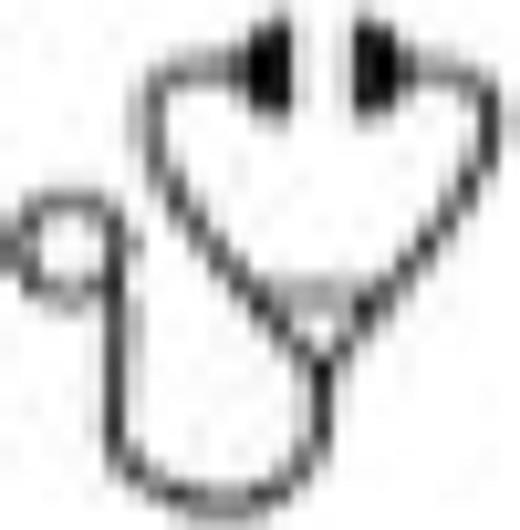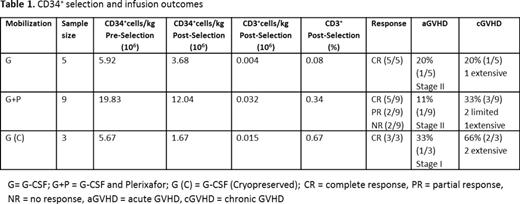Abstract

Introduction: CD34+-selected peripheral blood stem cell infusions without conditioning have recently been utilized for poor graft function (PGF) with promising results. Unfortunately, many patients have been unable to receive the boost infusion as their donors were unwilling or unable to undergo an additional stem cell collection. Therefore, we conducted this pilot trial utilizing either fresh or cryopreserved peripheral blood stem cell products to create CD34+-selected peripheral blood stem cell infusions for the treatment of PGF. Additionally, to explore relationship of CD34+ dose and response we included a cohort of donors mobilized with plerixafor in addition to the standard G-CSF.
Methods: Poor graft function (PGF) was defined as ANC < 0.5k/μL, platelets < 30k/μL, or platelet or RBC transfusion dependence despite full donor chimerism and in the absence of GVHD more than 60 days following allogeneic stem cell transplant (allo-SCT). Three different donor products were used for CD34+ selection: (1) fresh mobilized product using G-CSF only (SC at a dose of 10 μg/kg daily for 5 days), (2) fresh mobilized products using G-CSF (SC at a dose of 10 μg/kg daily for 5 days, days-4 through day 0) and plerixafor (IV at a dose of 320 μg/kg on day 0), and (3) cryopreserved cells mobilized with G-CSF (SC at a dose of 10 μg/kg daily for 5 days). Seventeen donor-recipient pairs were enrolled onto this prospective study. The original allo-SCT donor either underwent an additional peripheral blood stem cell (PBSC) mobilization and collection with G-CSF only (n=5) or G-CSF plus plerixafor (n=9) or a cryopreserved product (n=3) from a previous collection (using G-CSF only) was used to create the CD34+ cells for infusion. CD34+ cell selection was performed using a CliniMACS. The infusion was not preceded by administration of any chemotherapy or conditioning regimen. Neutrophil improvement was defined as neutrophil count > 500/μl without growth factor support for >7 days; platelet improvement was defined as platelet count ≥ 50,000/µl without platelet transfusion support for > 7 days; and RBC improvement was defined as hemoglobin > 9 g/dL and transfusion independence. Complete response was defined as improvement of all involved cells lines; partial response was defined as improvement of platelets and/or neutrophils with continuing RBC transfusion dependence.
Results: The mean post-selection CD34+ count per kg of recipient weight was 3.7x106, 12x106, and 1.7x106 for G-CSF only, G-CSF plus plerixafor, and cryopreserved products, respectively. Mean CD34+ yields (defined as the number of CD34+ cells after selection/CD34+ cells prior to CD34 selection) was 58%, 67%, and 31% for G-CSF only, G-CSF plus plerixafor, and cryopreserved products, respectively (Table 1 and Figure 1). The mean number of CD3+ T cells/kg infused in each product was 0.004 x 106, 0.032 x 106, and 0.015 x 106 for G-CSF only, G-CSF plus plerixafore and cryopreserved groups respectively (Table 1). Following the CD34+-selected stem cell infusion, 12 of the 17 recipients (71%) had a complete response including all 3 who received cryopreserved products; 3 had a partial response (17%) and 2 patients (12%) did not respond. One year relapse-free and overall survival was 71% and 65%. There was no treatment related toxicity reported other than graft-versus-host-disease (GVHD); three (18%) developed acute GVHD (1 grade I localized to the skin, 2 grade II with gut involvement), 6 chronic GVHD (2 limited and 4 extensive) (Table 1).
Conclusion: Cryopreserved products seem to be a viable alternative to create CD34+ -selected peripheral blood stem cell infusions for the treatment of PGF. When collecting fresh products is an option, the addition of plerixafor increases CD34+ yield over G-CSF alone.
Abboud:Teva Phamaceutical: Research Funding. Uy:Novartis: Research Funding.
Author notes
Asterisk with author names denotes non-ASH members.

This icon denotes a clinically relevant abstract



This feature is available to Subscribers Only
Sign In or Create an Account Close Modal